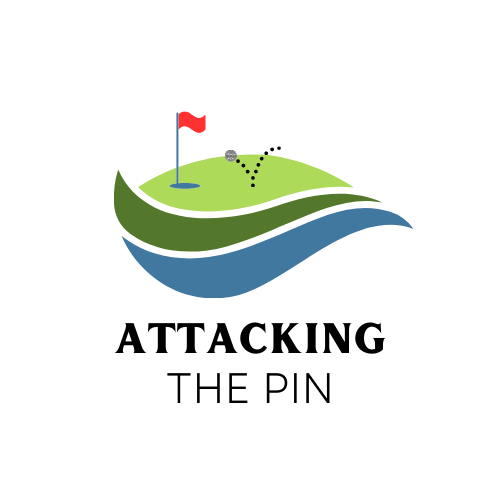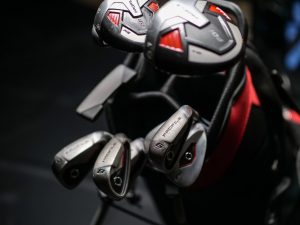The most common club set configuration is:
- Driver
- 1-2 Fairway Woods
- 1-2 hybrids or utility irons (UI)
- Irons from 3 – 9 (depending on hybrids)
- Some combination of PW, GW, SW, LW
- Putter
If you go into a sporting goods store and ask for a full set of golf clubs, this is the configuration you are most likely to find. But just because club manufacturers package complete club sets this way does not mean it’s right for you.
The secret to playing good golf can be summed up in two words: distance and direction. So the answer to the question of what clubs should I have in my bag is the clubs that you can afford that make it most likely you will hit the ball the right distance and in the right direction.
The clubs that accomplish that are going to vary from player to player and will change over time. The more honest you are willing to be about your golf game, your financial situation, and your goals moving forward, the better you’ll be at putting together a set of clubs that works for you.
Before we start, we need to accept that golfers tend to be a prideful group. Many golfers pick their clubs based on what their favorite professional golfers use or which company has the best advertising. Club manufacturers know this and spend millions every year trying to entice you — and golfers spend millions every year in the hopes that the latest and greatest club is going to be the secret to improved golf. If you’ll try to take pride out of the equation, it will help you make better club decisions for you and your game.
I saw the benefit of this during the summer. Ever since high school, I’ve played a forged blade iron because I liked the way they looked and figured if they work for the pros I could make them work for me. My handicap was low double-digits so I thought I was doing alright.
This summer I came across a screaming deal on a set of used hybrid clubs. They were cheap and I was curious so I decided to give them a shot. The result was that I shaved several strokes off my average score.
The end of the summer culminated in breaking 80 for the first time in my life. In our club championship, no less! While I’m no scratch golfer, playing clubs that better fit my game has made a huge difference for me.
Our goal in this post is to better equip you to put the right clubs in your bag. We don’t want you to think that putting the right clubs in your bag is all that stands between you and scratch golf. We’re all a lot further than a $1,000 golf set away from the PGA Tour. After all, pro golfers could beat most of us with any set of clubs you handed them. But that doesn’t change the fact that the right bag of clubs will help you play better.
If you’re not familiar with the different types of clubs we’re referring to or just want more information, check out our blog post on different types of clubs.
What clubs should I have in my bag based on my handicap?
Players at different handicap levels are going to have different needs on the course and will have different abilities to hit certain types and lofts of clubs. The higher your handicap the more ‘help’ you need from the clubs in your bag. Conversely, low-handicap players want clubs they can ‘work’ to produce specific and more creative shots.
Below are lists of clubs commonly carried by players at different handicap levels. These are just general guidelines so don’t read too much into them.
High handicappers bag
- Driver
- 3 and 5-woods
- 3, 4 and 5 hybrid/UIs
- 6, 7, 8 and 9 irons
- PW, SW
- Putter
Mid handicappers bag
- Driver
- 3 and 5-woods (5-wood sometimes replaced with 2-hybrid/UI)
- 3, and 4 hybrids/UIs
- 5 hybrid or iron
- 6, 7, 8 and 9 irons
- Pitching wedge
- Gap wedge
- Sand wedge
- Putter
Low handicappers bag (any iron can be replaced with hybrid
- Driver
- 3-wood
- 5-wood or 2 hybrid/UI
- 4-iron through 9-iron
- Pitching wedge
- Gap wedge
- Sand wedge
- Lob wedge or 3-iron
- Putter
Each bag will be different
Sports Marketing Surveys, which conducts a bag census for some of the PGA tournaments, published data from the 2021 Open Championship. Based on their survey, they identified a total of 29 different bag setups among the PGA tour players. Another one of their graphs shows how players play different clubs depending on what tournament they are playing in.
One of the strangest club decisions is the choice of Phil Mickelson to often carry two drivers in his bag. He often carries both a 1-wood driver and a 2-wood “mini” driver and used this bag setup to win the 2006 Masters. Lefty’s club decisions just go to show you that there is no cookie-cutter bag setup for great golf.
How should I decide what should go in my bag?
While personal preference is ultimately the key, there are some general guidelines that can help you start to decide what clubs you want to carry with you on the golf course.
Remember that the key to golf is distance and direction. The goal of your club decisions should be to strike the best balance for your game between power and control. Again, try to not let pride get the best of you. Taking an honest look at your game, both your strengths and your weaknesses, will help you make smarter decisions. After all, would you rather be the golfer with the fanciest, most expensive golf clubs or the golfer with the lowest score? We’ll take scorecard any day.
Driver
The vast majority of players should carry a driver in their bag. If high handicap players don’t feel comfortable hitting their driver off the tee, it is okay to hit a 3- or a 5-wood initially. However, driver technology has progressed to the point that drivers are extremely forgiving.
Distance off the tee is absolutely key in lowering scores, so learning to hit a driver consistently is key to helping players improve their overall game. There is just no excuse not to get to the driving range and get comfortable hitting a driver. For more information on why distance is important, check out our post about how far you should hit your golf clubs.
Get Your Scoring Clubs Right
In addition to a driver, all bags should have two wedges and a putter. For a bogey golfer, about 40% of shots taken during a round of golf are going to be with the putter. Obviously, this varies considerably from player to player and from round to round. Regardless, the fact remains that if you want to lower your golf scores, avoid those three-putts. Finding a putter you like and practicing so that you can confidently putt the ball is critical to lowering your scores.
Similarly, hitting good shots around the green to set up shorter putts is another shot-saving opportunity. Having at least two wedges with which you feel comfortable around the green is extremely helpful. For a two-wedge setup, a pitching wedge and sand wedge is the most common combination. Good wedge play is often the difference between a good and a bad round so find wedges that work for you and practice your green side play.
One thing that we’ve heard some people do is carry two putters. Apparently, the thinking is that it helps them with the yips if they are able to pull out different putters. While everybody has to do their own thing, golf rules only allow you to carry only 14 clubs. It seems foolish to waste one of those clubs on an extra putter.
Two suggestions we might make if you’re carrying two putters. First, keep practicing. Muscle memory is your friend as it relates to putting. Sure, lots of us struggle with the yips, but grooving a consistent putter stroke solves a lot of those issues.
The second option is to look at different putter grips. If you absolutely feel that you need to make a change when the yips start sneaking up on you, how about changing your putter grip? You could go to the claw or cross-handed grip or any other you choose. You are getting the change you are looking for without wasting a precious spot in your bag for a second putter.
3-4 Long Clubs
After selecting your driver and your scoring clubs, the next clubs you should look for are your long clubs. these may be any of the following:
- 3-wood
- 2-hybrid/UI
- 5-wood
- 3-hybrid/UI
- 4-hybrid/UI
- 5-hybrid/UI
These are clubs that shorten par 5s and make long par 4s more reachable. They are also easier clubs to hit from different lies, so having the right selection in your bag can make a huge difference. Of the 156 players in the 2021 Open Championship, only nine didn’t have a fairway wood, and only 20 carried less than two fairway woods, hybrids, or utility irons (19 of which carried a fairway wood and 3-9 irons). If pros use these clubs, then we should definitely at least pay attention.
Not every golfer is eager to add a hybrid to their bag, thinking a 3-wood is good enough and wanting to carry the more traditional and sexy long irons. Especially for high-handicap players, hybrids offer a larger sweet spot and are easier to consistently elevate the ball than long irons. Hybrids are designed with numbers to tell you which iron to replace. Testing out a few different ones is best. However, after using a few different hybrids, I’ve found that I enjoy hitting pretty much any of them. More than 50% of pros have one or two hybrids in their bag in place of long irons.
Dialing in Your High Irons
If your highest-loft long club is a 4-hybrid, you should get irons 5 through 9, if it is a 5-hybrid, you should get irons 6 through 9, etc. The goal with your high irons is to fill your yardage gaps.
It is also important that your iron selection fits your level of play. If you are just starting the game, player-improvement irons will be much more beneficial than a fancier, but much more difficult to hit, set of blades. If you are a better player, clubs that allow you to work the ball more may prove helpful as you increase your creativity around the course.
Additional Clubs
Now it is time to fill out your bag. You should have anywhere from two to four spots remaining in your bag. Additional clubs you might select would include:
- Additional wedge or two
- Additional long club
- Chipper
If you are missing a 5-wood, that might be a club you decide you want in your bag. If you continue to struggle around the greens from certain distances, it might be worth adding a wedge to fill in the gaps.
Starting out with some room in your bag (10-12 clubs you feel confident you want) and filling them in as you identify your needs on the course can be a great way to fill your bag with clubs you actually need. An added bonus of a few empty spaces in the bag is that you’ll be lugging around a bag that is just a little bit lighter!
Confidence Matters
Confidence in your clubs is paramount to scoring well on the golf course. If you have an old wood driver that you consistently hit 250 yards off the deck and want to play it instead of a 3-wood, keep it in the bag. If you have a 7-iron and a 7-hybrid you love and hit different distances, keep them both. If playing 11 clubs gives you more confidence in your club selection, then play 11 clubs. It’s more important to choose your set based on your needs and not the industry standard or what you see pros or your buddies carrying.
If you are just getting started, finding a used set of clubs is a good way to go as well. There is no shame in saving a few bucks.
On the other hand, if you’ve got the money, it’s always a great idea to get fitted by a professional. They’ve worked with lots of players and can have some great insight into what clubs might be best for you.
One other tip is to carefully track a few rounds club by club. This can help you determine if there are any clubs you aren’t using or any clubs you use regularly but which you don’t really like.
How Far Should They Go?
Hopefully, this info has provided you food for thought about your clubs. There is no question that the right clubs will make golf more fun.
A common follow-up question to what clubs should I have in my bag is how far should I hit my clubs. Check out our club distance guide.
Share with us in the comments any unique bag setups that you have or clubs that you’re wanting to try. We’d love to get your feedback.






